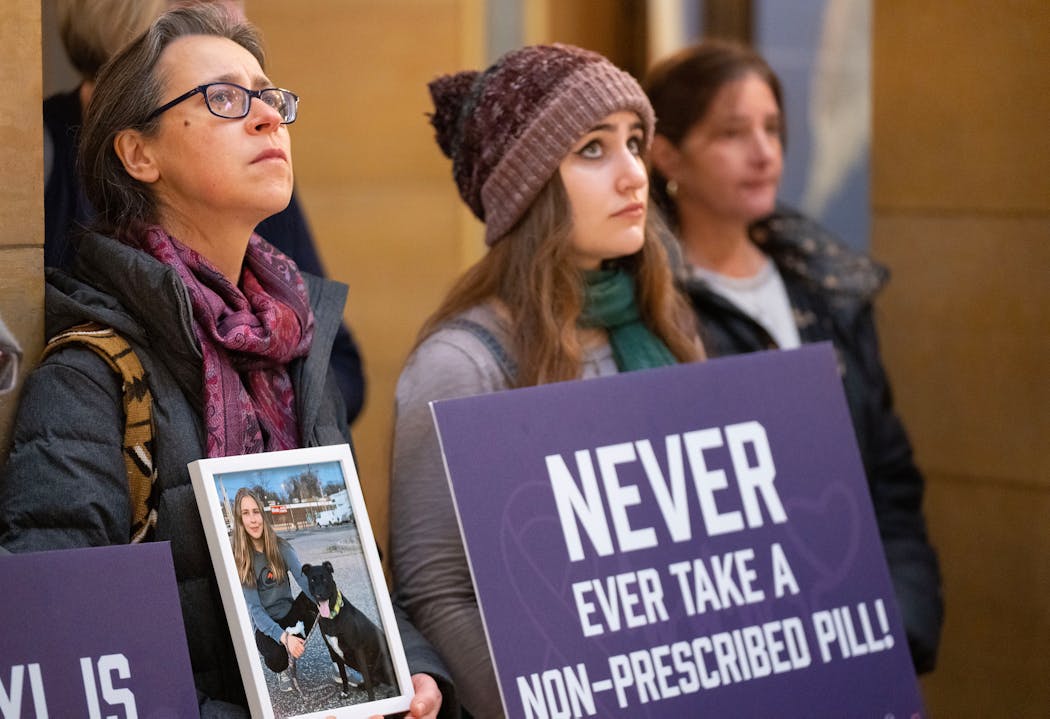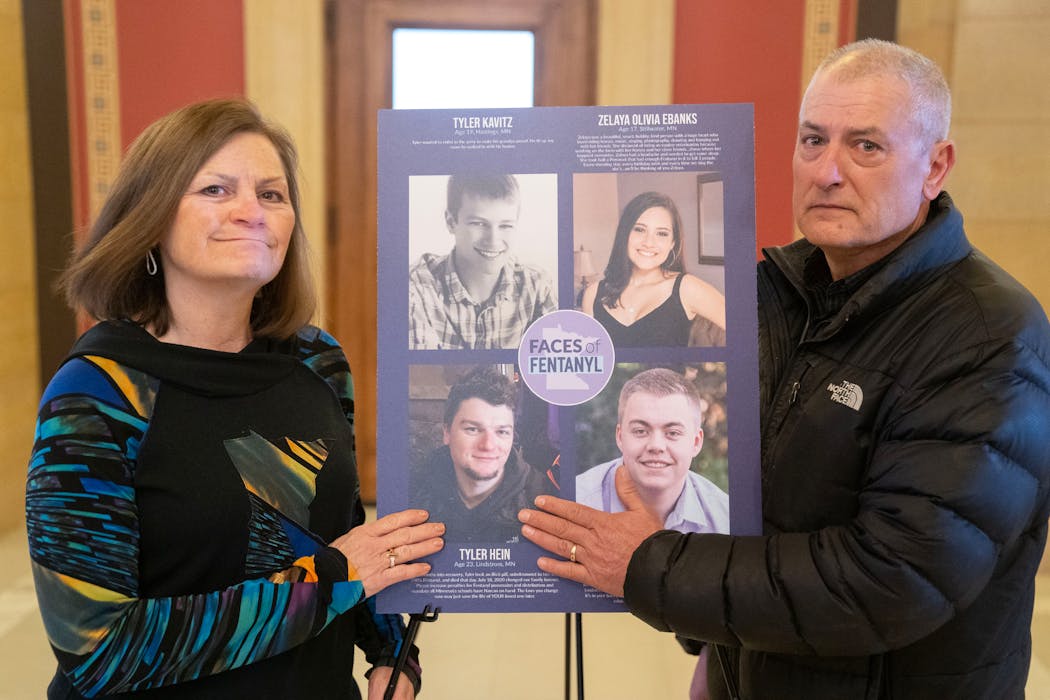Their faces are displayed in a quiet corridor of the State Capitol.
The 17-year-old Bloomington football player whose friend gave him a fentanyl-laced Percocet. The Minnetonka mother who had a 3-month-old baby and was just accepted to cosmetology school. A Willmar man whose hockey injury led to addiction. Prince.
They are among hundreds of Minnesotans who've died each year from overdoses involving opioids. Deadly overdoses have reached an all-time high in the state, killing twice as many people as car crashes in 2021. Most of the deaths are linked to fentanyl.
"It's unfathomable to me that our government has not done more to stop this drug from infiltrating every community, every demographic in our country," said Michele Hein of Lindstrom, who lost her son to an overdose. "This is a public health emergency."
At a Capitol rally Tuesday, advocates said Minnesota could help prevent more deaths if it required schools and first responders to carry naloxone, the drug that can reverse an overdose. Some, including Hein, wonder why the more-deadly fentanyl isn't classified by law on par with heroin, and they see increased penalties as critical.
Disagreements abound over how best to respond to the crisis. But advocates agree on one point: The government has not done enough as deaths have climbed.
Colleen Ronnei has long asked state leaders to require schools to have a supply of naloxone, the generic form of Narcan. Since schools often serve as community centers where people gather for sports or other events, having a couple of doses of the easy-to-administer nasal spray version of the drug could save students, staff, parents or other visitors, she said.
But school officials have raised concerns about liability, who can administer the drug and imposing an unfunded mandate, said DFL Sen. Kelly Morrison, a physician from Deephaven who has worked with Ronnei on the bill for years. In past attempts, the bill became watered-down to say schools may have naloxone instead of requiring it, to the point where it was "worse than having no bill at all," said Ronnei, executive director of the nonprofit Change the Outcome.
Morrison said she is optimistic they could pass the requirement this year, noting legislators are working to expand who can administer such drugs from only nurses to all school personnel. She estimated getting the drug in all schools would cost about $200,000, which the state would cover.
"It's just such an easy solution to get ahead of it. Do we want to wait until we have students dying in our high schools or middle schools to do something?" said Ronnei, who lost her son Luke to an overdose seven years ago.
The state should also mandate that police, fire and emergency medical services workers carry naloxone, said Alicia House, executive director of the Steve Rummler HOPE Network. Her organization provides free naloxone and trains people to use it.
Some Minnesota communities are not interested in having all police squads or emergency medical service providers carry the drug, House said. She said her organization has run into misinformation and stigma around naloxone.
"We still see those groups around Minnesota saying, 'No.' And that's crazy to me," House said. "I think everyone assumed that when we made it accessible and legal, that why wouldn't you?"
Advocates are divided over another bill that has been in the works for years.
Penalties around possession and sale of drugs are tied to weight, and the bill would align the amount of fentanyl with heroin. Patricia Bittner of the Leech Lake Tribal Police held up bags of sugar and flour at Tuesday's rally to illustrate that someone currently needs to be carrying significantly more fentanyl than heroin to face the same penalties.
Fentanyl is up to 50 times stronger than heroin, according to the Centers for Disease Control and Prevention.
"The flow of these drugs is completely out of hand and we've got to put these people away," said the bill's sponsor, Rep. David Baker, R-Willmar. "Right now the law enforcement agencies do not have that authority like they need."
Some advocates and DFL lawmakers are wary of such changes. House and Ronnei both said they want to hold big-time dealers accountable, but fear the bill could lock up people who are buying a small amount for themselves or a few friends and stressed that they would rather see them get help than land in prison.
The efforts to increase penalties and put naloxone in schools are two of many ideas being considered this session. Another bill would allow community-based public health programs to provide sterile needles, syringes and other injection equipment along with other treatment and prevention services. Syringe providers are also major distributors of fentanyl test strips, which detect whether there's fentanyl in drugs, said Eddie Krumpotich with the National Harm Reduction Coalition.
Gov. Tim Walz's budget would spend $22 million over the next two years on a Comprehensive Drug Overdose and Morbidity Prevention Act. It includes connecting people with non-opioid pain management, providing targeted outreach, gathering more data on drug overdoses and expanding the work of regional overdose prevention teams.
Federal lawmakers are also contemplating action.
During his State of the Union address, President Joe Biden called for stronger fentanyl trafficking penalties, more drug detection machines at the U.S.-Mexico border and partnerships with delivery companies to inspect packages.
Democratic U.S. Rep. Angie Craig was in Texas last week for a committee field hearing on the fentanyl crisis, and said more enforcement is needed at ports of entry. Craig said she is considering introducing a bill to put more grant dollars toward helping educate kids about fentanyl and is looking at how to hold social media companies accountable when dealers use those platforms to market illicit drugs.
At Tuesday's rally, Craig addressed a crowd filled with parents and family members who lost a loved one. She told the story of one man who bought what he thought was a Percocet from a dealer on Snapchat.
It turned out to be 100% fentanyl. The 19-year-old former Hastings honor student who loved football and writing music died in his sleep.
Utah GOP picks Trump-backed mayor as nominee to replace Sen. Mitt Romney, but primary foes await
A Hawaii military family avoids tap water at home. They're among those suing over 2021 jet fuel leak

Chants of 'shame on you' greet guests at White House correspondents' dinner shadowed by war in Gaza




